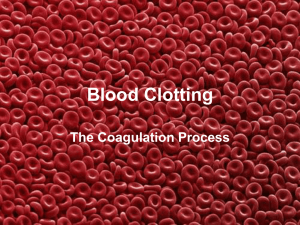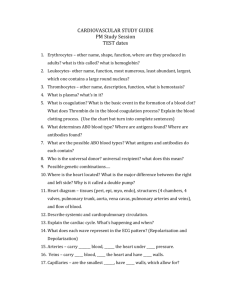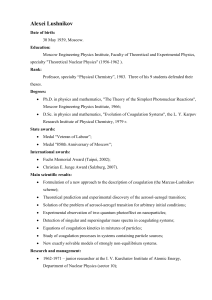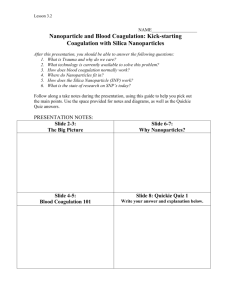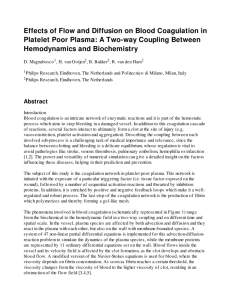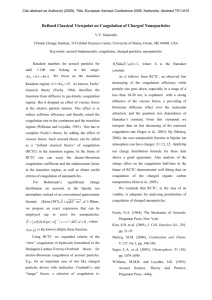Situational tasks- (ситуационные задачи)
advertisement
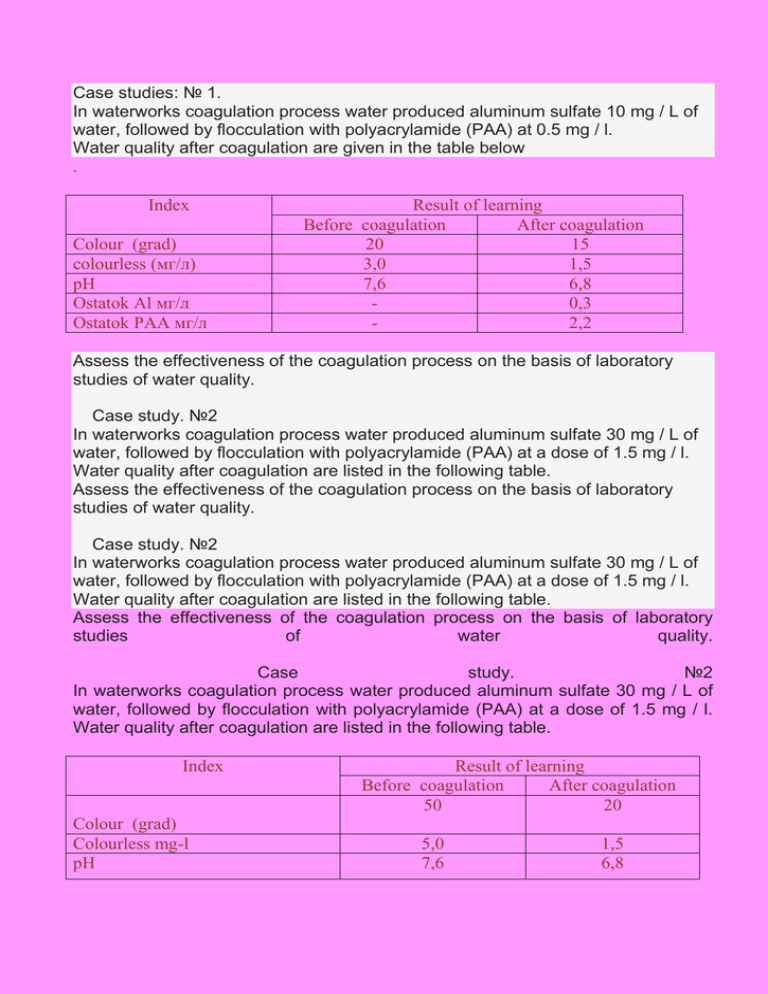
Case studies: № 1. In waterworks coagulation process water produced aluminum sulfate 10 mg / L of water, followed by flocculation with polyacrylamide (PAA) at 0.5 mg / l. Water quality after coagulation are given in the table below . Index Colour (grad) colourless (мг/л) рН Ostatok Al мг/л Оstatok PАА мг/л Result of learning Before coagulation After coagulation 20 15 3,0 1,5 7,6 6,8 0,3 2,2 Assess the effectiveness of the coagulation process on the basis of laboratory studies of water quality. Case study. №2 In waterworks coagulation process water produced aluminum sulfate 30 mg / L of water, followed by flocculation with polyacrylamide (PAA) at a dose of 1.5 mg / l. Water quality after coagulation are listed in the following table. Assess the effectiveness of the coagulation process on the basis of laboratory studies of water quality. Case study. №2 In waterworks coagulation process water produced aluminum sulfate 30 mg / L of water, followed by flocculation with polyacrylamide (PAA) at a dose of 1.5 mg / l. Water quality after coagulation are listed in the following table. Assess the effectiveness of the coagulation process on the basis of laboratory studies of water quality. Case study. №2 In waterworks coagulation process water produced aluminum sulfate 30 mg / L of water, followed by flocculation with polyacrylamide (PAA) at a dose of 1.5 mg / l. Water quality after coagulation are listed in the following table. Index Colour (grad) Colourless mg-l рН Result of learning Before coagulation After coagulation 50 20 5,0 7,6 1,5 6,8 Ostatok Al mg/l - 0,1 - 0,5 Оstatok PАА mg/l Assess the effectiveness of the coagulation process on the basis of laboratory studies of water quality. Case studies: № 3 In waterworks coagulation process water produced aluminum sulfate 40 mg / L of water, followed by flocculation with polyacrylamide (PAA) at a dose of 1.5 mg / l. Water quality after coagulation are listed in the following table. Index Показатели Colour (grad) Colourless рН Ostatok Al mg/l Оstatok PАА mg/l Result of learning Before coagulation After coagulation 40 15 3,0 7,6 - 1,5 6,8 0,5 - 1,2 Assess the effectiveness of the coagulation process on the basis of laboratory studies of water quality. Solution of the problem. The results of coagulation of water is estimated according to GOST 950-2000 "Drinking water". Indicators of water color by Guest are not more than 20 degrees and 15 degrees, the result is correct. Turbidity is normally 1.5 mg / l and after coagulation and 1.5 mg / l compliance. Residual aluminum and residual PAA before and after the missing coagulation coagulation results correspond to normal. The efficiency of the coagulation process with a dose of 40 mg / L of coagulant and 1.5 mg / l PAA flocculant sufficient to improve drinking water quality organoleptic properties. Case study. №4 In waterworks coagulation process water produced aluminum sulfate 20 mg / L of water, followed by flocculation with polyacrylamide (PAA) at 0.5 mg / l. Water quality after coagulation are listed in the following table. Index Colour (grad) Colourless Result of learning Before coagulation After coagulation 50 35 5,0 2,5 рН 7,6 6,8 Ostatok Al mg/ 0,7 Оstatok PАА mg/l 1,5 Assess the effectiveness of the coagulation process on the basis of laboratory studies of water quality. Solutions The results of coagulation of water is estimated according to GOST 950-2000 "Drinking water". Indicators of water color by Guest are not more than 20 degrees, 35 degrees and the results do not meet safety standards. Turbidity is normally 1.5 mg / l and after coagulation of 2.5 mg / l is not correct. Residual aluminum in the norm of 0.5 mg / l after coagulation and residual PAA 0.7 OK 2.0 mg / l after coagulation correspond to normal. The effectiveness of the coagulation process in doses of 20 mg / l of coagulant and 0.5 mg / L PAA flocculant is not enough to improve the quality of drinking water meets the requirements of GOST "Drinking Water" for organoleptic properties. Case studies: № 5 In waterworks chlorination process performed by simple dose and have found that if water-index -2-microbial numbers 40, residual chlorine, 0.3 mg / l. Assess the effectiveness of chlorination process on the basis of laboratory studies of water quality. Solutions: Bacteriological examination of water and determination of residual chlorine in the water line indicates the observed water-quality art 950-2000 Dove "Ichimlik Suvi". The process of neutralization of the water at the waterworks is carried out efficiently . Situational problems number 6 At Waterworks held daily bacteriological analysis of water every hour and determine the residual chlorine. The results showed coli index 5, the microbial numbers 107, residual chlorine of 0.1 mg / l. Evaluate the use of water. Solutions: Bacteriological examination of water and determination of residual chlorine in water indicates not according to the observed water-quality art 9502000 Dove "Ichimlik Suvi". The process of neutralization of the water at the waterworks is carried out is not effective. Case studies: № 7. At the waterworks had chlorination process simple and at the same dose in water found coli index -5, microbial number 137, residual chlorine, 0.5 mg / l. Assess the effectiveness of chlorination process on the basis of laboratory studies of water quality. Case studies number 8 At Waterworks held daily bacteriological analysis of water every hour and determine the residual chlorine. The results showed coli index-3 microbial count 197, residual chlorine of 0.5 mg / l. Evaluate the use of water. Case studies: № 9 In waterworks chlorination process performed by simple dose and have found that if water-index -6-microbial numbers 140, residual chlorine, 0.01 mg / l. Assess the effectiveness of chlorination process on the basis of laboratory studies of water quality. Case studies number 10 At Waterworks held daily bacteriological analysis of water every hour and determine the residual chlorine. The results showed coli index 5, the microbial numbers 187, residual chlorine 0.02 mg / l. Evaluate the use of water.
